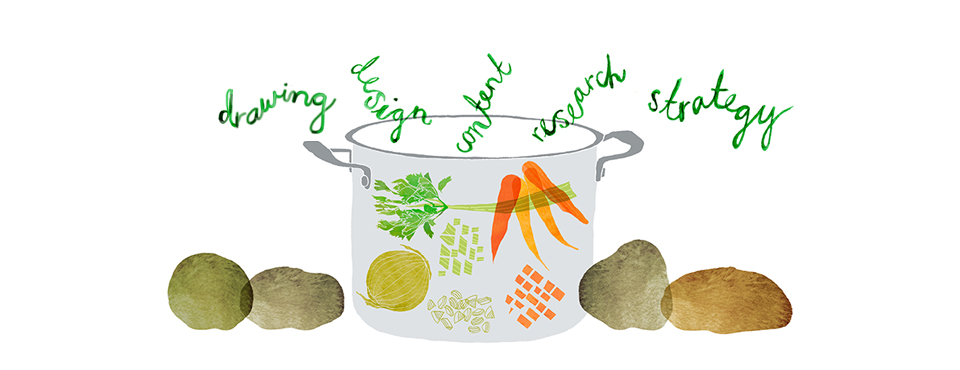When the Stone Soup story is interpreted through an entrepreneurship lens, the full flavors of community and collaboration unfortunately go to pot.
I am often asked how I came up with the name Stone Soup for my business. I refer to the popular children’s book, first published in 1947, which was based upon an even older European fable. Here is the super-abridged, shorty-short version:
Hungry travelers arrive in a village. Food is scarce, and the villagers are unwilling to share what they have. The ingenious travelers begin a pot of soup by placing a ‘magic stone’ in boiling water. Curious villagers stop by, each sharing an ingredient to add to this stone soup. Ultimately, a delicious, nourishing pot of soup feeds everyone.
Got the gist? Feel free to skip this slightly longer version:
Some travelers come to a village, carrying nothing more than an empty cooking pot. Upon their arrival, the villagers are unwilling to share any of their food stores with the very hungry travelers. Then the travelers go to a stream and fill the pot with water, drop a large stone in it, and place it over a fire. One of the villagers becomes curious and asks what they are doing. The travelers answer that they are making “stone soup”, which tastes wonderful and which they would be delighted to share with the villager, although it still needs a little bit of garnish, which they are missing, to improve the flavor.
The villager, who anticipates enjoying a share of the soup, does not mind parting with a few carrots, so these are added to the soup. Another villager walks by, inquiring about the pot, and the travelers again mention their stone soup which has not yet reached its full potential. The villager hands them a little bit of seasoning, like potatoes, onions, cabbages, peas, celery, tomatoes, corn, meat, milk, butter, salt and pepper. More and more villagers walk by, each adding another ingredient. Finally, the stone (being inedible) is removed from the pot, and a delicious and nourishing pot of soup is enjoyed by travelers and villagers alike. Although the travelers have thus tricked the villagers into sharing their food with them, they have successfully transformed it into a tasty meal which they share with the donors.
Told in many renditions, sometimes travelers come to the village; others tell of soldiers; or a tramp; or even a monk. I chose the name because I felt it was a good metaphor: a story of creativity, ingenuity and teamwork, of creating something from nothing.
I am not the only one to recognize a quality analogy when I see one. Recently I came across this 2014 post from Peter H. Diamandis, an entrepreneur, described as a futurist and visionary, with his take on the same fable. But some of his thinking rubs me the wrong way, and because I am invested in the name and the story, I feel compelled to write about it.
Success is in the stones
Basically his thesis is that making ‘stone soup’ is equivalent to an entrepreneur’s passion. It’s a metaphor for entrepreneurship and leadership success.
The stones are, of course, your passion, your labor and your big bold idea; the contributions of the villagers are the capital, resources, and intellectual support offered by investors and strategic partners. Everyone who adds a small amount to your stone soup is in fact helping to make your dream come true.”
– Peter H. Diamandis, Stone Soup
This entrepreneur’s point of view seems so self-serving to me. One of the powerful meanings of the story is that the soup serves everyone, including the reluctant villagers, not just the savvy travelers. Yes, the villagers are tricked, but in a benevolent way that results in collaboration, cooperation, partnership. Just like any creative project that comes together successfully with multiple inputs, progress is achieved. Everyone enjoys a feast, and the community is transformed.
Critical thinking over blind passion
Diamandis also writes:
Most important in making stone soup work is your passion. People love passion. People love to contribute to passion. And you can’t fake it.
The human BS detector is great at spotting the inauthentic player: the used car salesman, the carnival barker, and the disingenuous politician always rub us the wrong way.”
Is the 100% authentically passionate person automatically an angel? I think not. Just because someone speaks confidently and acts boldly does not make them a leader to be followed blindly.
Yet, humans fall for BS all the time. They like people who talk big. There are countless examples of startup frauds. Theranos and their fictitious blood testing technology comes to mind, as does Billy McFarland’s Fyre Festival.
He continues:
People who pursue their passions inevitably create beacons that attract others who share their vision… Few of these beacons are consciously created; they are byproducts of pursuing one’s passion. Passionate people share their creations widely, leaving tracks for others to find them.”
To the followers of beacons of passion, I offer this advice: please be cautious following tracks laid by others. The beacon could be illuminating benign enthusiasm, or a greedy transaction.
Value and Empowerment
I’m an entrepreneur in the sense that I started and continue to run my own business. But I’m also in a service industry. Graphic design and graphic recording serve to provide visual solutions to client problems:
– How can we make people aware of our mission?
– How can we get people to engage with us?
– How can we make this idea/product/event more meaningful?
My work is to make their dreams come true – by meeting goals and objectives – not the other way around.
One book reviewer even believes the Stone Soup story is a symbol for empowerment: “To get what you want from others, you cannot simply ask. You must empower people to put them in the position that they can assess what value their input to a situation can bring.”
…
What do you think? Is the fable open to many interpretations? What’s your take?
- https://www.goodreads.com/book/show/193093.Stone_Soup
- https://en.wikipedia.org/wiki/Stone_Soup
- https://www.diamandis.com/blog/stone-soup
- https://www.entrepreneur.com/article/317721
- https://www.success.com/25-successful-people-wholl-help-change-your-life-in-2018/
- https://www.washingtonpost.com/news/wonk/wp/2015/10/15/i-asked-psychologists-to-analyze-trump-supporters-this-is-what-i-learned/
- https://www.vanityfair.com/news/2016/09/elizabeth-holmes-theranos-exclusive
- https://www.washingtonpost.com/arts-entertainment/2018/10/11/fyre-festival-was-total-disaster-its-founder-is-going-prison-wire-fraud/
Want more on Visual Communication and Visual Thinking? Here's some related content for you.
Top Ten Doodles for Visual Communication
Drawing out concepts and ideas instead of writing down words is an effective way to communicate. Doodles are simple shapes and symbols that can be drawn in all kinds of situations. Plus it’s fun, and you don’t need to be an “artist” to do it.

